Photography courtesy of Lowell Washburn, all rights reserved.
It’s mid-February and the North Iowa landscape remains in lockdown. Although today’s skies are clear and sunny, morning temperatures have failed to rise above a finger numbing ten degrees below zero. But the wind is down and, once we’ve dressed in proper attire, it seems a perfect day to explore local wetlands.
Once we arrive, the winter marsh appears void and desolate. At first glance, the place seems as inhospitable to life as the dark side of the moon. At this season, there is no clamor of bird song to greet the morning sunrise. There is no croaking of frogs; no periscoped heads as painted turtles peer above the water’s surface. Instead, there is only frozen silence — a silence that conveys an overwhelming sense of complete solitude.
But first impressions are often deceiving. And once we begin our walk, it doesn’t take long to discover that, even now, the marsh is brimming with life. The current abundance of bird and mammal tracks offers a wealth of pertinent information. It is here, in the stark freshness of recent snowfalls that we find the outdoors’s version of the morning newspaper. Like most good newspapers, the snow provides information on social gatherings, social strife, and even occasional tragedies. It shows where the pheasants are roosting, which weed seed buffets are being frequented by hungry deer mice, and where a resident weasel has set up winter headquarters beneath a forgotten fenceline rock pile.
Should we dare to venture beyond the ‘light reading’; snowscape scribblings can also provide a deeper insight into a world that many humans have forgotten exists. It is the harsh reality of predator and prey — a realm where the natural world is neatly divided into two categories. One is the hunter; the other is the hunted. In this high stakes, winner take all game of survival there are no trade-offs, no political correctness, no compromise. There is simply a winner and a loser.
Although the tense balance between predator and prey is amazingly dynamic, the basic premise is simple. Prey species, such as mice and rabbits, have a stunning capacity for reproduction. Predators — hawk, fox, and weasel — do not. Life nurtures life, and the scales may tilt in either direction. Until the game is played to its inevitable conclusion, the final outcome remains uncertain. Yet somehow, in both good years and bad, the fragile rhythm endures. The cycle of life continues
The snow records the tales. Etched upon winter’s white tablet, the daily events are vividly portrayed for all to see — briefly recorded snippets that detail close encounters, hard chases, and near misses. Occasionally, we discover where the prey has lost its race — a pile of feathers, a tuft of fur, or perhaps a widening red spot in the snow where one life has ended so that another may continue. There can be little doubt that the existence between predator and prey represents an uneasy relationship. But as each player acts out its part, the individual struggle for survival becomes the very essence of the natural rhythm of life.
The latest set of tracks provides a good example of the rhythm in action. Near the edge of the cattails, a hungry cottontail has ventured out into the open to girdle bark from a clump of dogwood. It is a foolish move and one that does not go unnoticed by the red-tailed hawk perched in the branches of an oak tree located a hundred yards distant. The hawk, also hungry, bobs its head and launches the attack.
Realizing its mistake, the winter-lean rabbit flees for cover. Although the cottontail is soon covering ground with spectacular two foot leaps, the red-tail has already come halfway across the marsh. As the hawk closes, the rabbit begins a series of lightning fast, evasive maneuvers that buy a few more seconds of life. The raptor mimics the moves, growing ever closer with each powerful stroke of its wings. The cottontail is but a single leap from safety when the rapidly moving forms finally converge in a puff of snow.
A rabbit dies. A hawk feeds. The natural rhythm continues.

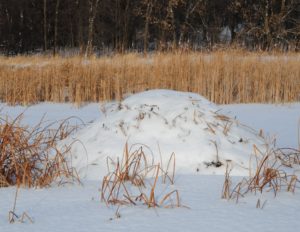
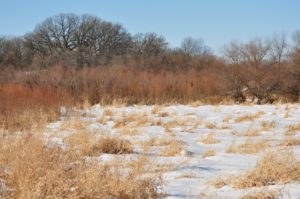
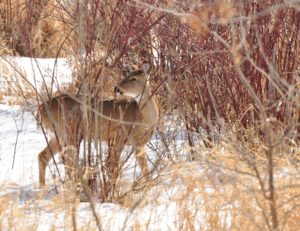

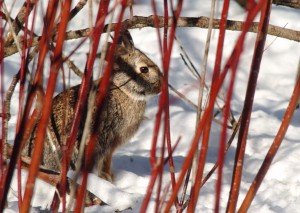
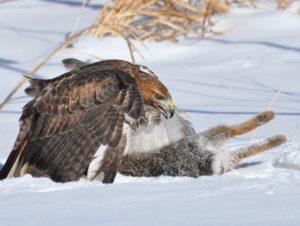
 Susan Judkins Josten
Susan Judkins Josten Rudi Roeslein
Rudi Roeslein Elyssa McFarland
Elyssa McFarland Mark Langgin
Mark Langgin Adam Janke
Adam Janke Joe Henry
Joe Henry Sue Wilkinson
Sue Wilkinson Tom Cope
Tom Cope Kristin Ashenbrenner
Kristin Ashenbrenner Joe Wilkinson
Joe Wilkinson Dr. Tammy Mildenstein
Dr. Tammy Mildenstein Sean McMahon
Sean McMahon